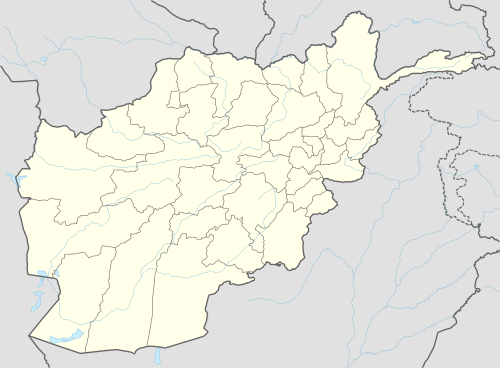Raid on Khataba
The Raid on Khataba, also referred to as the raid on Gardez, was an incident in the War in Afghanistan in which five civilians, including two pregnant women and a teenage girl, were killed by U.S. forces on February 12, 2010.[1][2] All were shot when U.S. Army Rangers [3] raided a house in Khataba village, outside the city of Gardez, where dozens of people had gathered earlier at the home to celebrate the naming of a newborn baby.[4][5] Initially, U.S. Military officials implied the three women were killed prior to the raid by family members, reporting that the women had been found "tied up, gagged and killed."[6] But investigators sent by the Afghan government reported, based on interviews and pictures of the scene, that the special operation forces removed bullets from the victims' bodies and cleaned their wounds as part of an attempted cover-up.[7] NATO denied this allegation, and Afghan investigator Merza Mohammed Yarmand stated, "We can not confirm it as we had not been able to autopsy the bodies."[6] The US military later admitted that the three women were killed by the special operations unit during the raid.[8]
| Raid on Khataba | |
|---|---|
| Part of the War in Afghanistan | |
| Type | Raid |
| Location | Khataba village, Paktia Province, Afghanistan 33°36′00″N 69°13′01″E |
| Date | 12 February 2010 4:00 a.m. (UTC+04:30) |
| Executed by | 75th Ranger Regiment |
| Casualties | 5 killed |
 Khataba Location of Khataba within Afghanistan | |
Response
NATO and the UN claimed to "not know of such an incident", but press leakage lead to a full investigation of the killings, but the bodies of the deceased were buried according to religious tradition before NATO could conduct autopsies to confirm the allegations.[8] Insisting that the deaths were a "terrible mistake"[9] Vice Admiral William McRaven, head of the JSOC, the command over the unit which conducted the raid, visited Khataba two months after the raid. He offered an apology and accepted responsibility for the deaths and made a traditional Afghan condolence offering of sheep.[10] The soldiers that had conducted the raid faced no disciplinary measures since they had followed the "rules of engagement".[11]
In media
- Dirty Wars, a 2013 American documentary by Jeremy Scahill.[12]
References
- Cavendish, Julius (April 9, 2010). "US Special Forces apologise for botched night raid". The Independent. London.
- Starkey, Jerome (March 15, 2010). "Survivors of family killed in Afghanistan raid threaten suicide attacks". The Times. London. Archived from the original on July 15, 2011.CS1 maint: BOT: original-url status unknown (link) (login required; )
- Naylor, Sean. Relentless Strike. St. Martin's Press. New York, NY. 2015. page 369. ISBN 978-1250014542
- Starkey, Jerome (April 5, 2010). "US special forces tried to coverup botched Khataba raid in Afghanistan". The Times. London.
- The Nation (April 5, 2010) "After denials, US admits Feb. killing of Afghan women"
- Oppel, Richard A.; Abdul Waheed Wafa (2010-04-05). "Afghan Investigators Say U.S. Troops Tried to Cover Up Evidence in Botched Raid". The New York Times. Retrieved 2011-09-02.
- AllGov.com (April 6, 2010) "NATO Admits U.S. Forces Killed Innocent Pregnant Women in Afghanistan"
- Tucker Reals (April 5, 2010). "Afghans: U.S. Troops "Covered-Up" Civilian Deaths". CBS News.
- Staff (April 9, 2010). "Special Forces chief begs forgiveness for killing five innocents". Edinburgh: The Scotsman.
- Julius Cavendish (April 8, 2010). "US military offers sheep in apology for Afghanistan deaths". Christian Science Monitor.
- Jeremy Scahill (June 1, 2016), "Pentagon: Special Ops Killing of Pregnant Afghan Women Was 'Appropriate' Use of Force". The Intercept_.
- "Dirty Wars". 18 October 2013 – via IMDb.